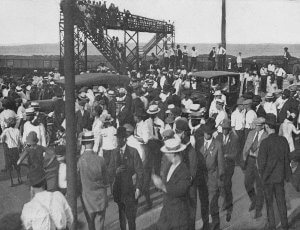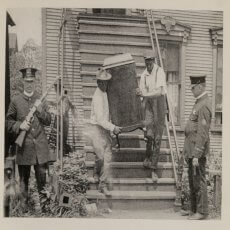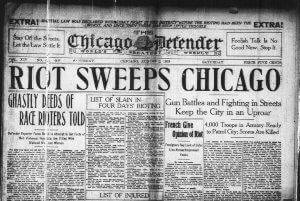Chicago race riots of 1919 were one of the nearly thirty race wars that swept across the country during the Red Summer of 1919.
Whites who feared and despised the social and economic growth of black people in northern industrial cities organized white-on-black violence in a barbaric state of rage and hostility.
In Chicago, for seven days, African American residents living in the city’s Black Belt district on the lower south side fought off white gangs and mobs.
The anti-black riot started on Sunday, July 27, 1919, seventeen-year-old African American teenager Eugene Williams was swimming in the waters of Lake Michigan.
During this time, whites reserved twenty-ninth street for themselves, while African Americans mostly used the beach along the lakefront near twenty-seventh street.
As the waves rippled through the water, Eugene drifted into a section of water occupied by white swimmers. Taking notice, white supremacists yelled racial slurs at the teenager.
On land, an argument and scuffle between whites and young blacks unfolded on the beach. The two groups threw heavy slabs of stone back and forth at each other.
Eugene, still in the waters of Lake Michigan, was also under attack by white males flinging stones at him. When Eugene did not come out of the water, a white boy similar in age entered the lake and swam toward Eugene.
As Eugene held on to a railroad tie, the white teenager struck him with a noticeably large stone, Eugene went under and did not reemerge. According to witness accounts, the police officers at the scene refused to arrest Eugene’s killer.
And so it begins, Chicago Race Riots of 1919

Day 1 July 27 Sunday Evening: No Faith in Police
News of Williams’ death spread quickly. Crowds of black and white people gathered at the lakefront. That evening, when young adult white males returned to their neighborhoods, they activated their gangs. By nightfall, white gangs descended on African-Americans living in predominantly white communities.
Between the hours of 9 pm and 3 am forty African-Americans had either sustained gun-shot wounds, severely beaten, or murdered. Black residents watched in horror and disbelief as their homes and businesses burned down.
Days 2 Monday: Drive-Bys and Snipers
There was a calm start to the morning work commute. However, by late afternoon white mob leaders and gang members started hanging out on street corners near the Stock Yards district, and other industrial business sites.
Caught-off-guard, unsuspecting black laborers on their way home from a hard day’s work were viciously dragged off street-cars and beaten with bats, clubs, and other lethal objects.
MEANWHILE….
The community referred to as the ‘Black Belt’ was the target of insane drive-by shootings. Crowded in trucks and automobiles, white people drove through the lower south side of black neighborhoods. The sound of their rifles and revolvers echoed throughout the streets.
In defense, black people took up arms and placed themselves in the shadows, “sniping” back at the white trespassers. Residents of the community also ambushed white looters who were destroying black businesses and stealing anything not bolted down.
By sunrise, reports showed nearly two dozen white men with stab wounds, attacked by heavy gunfire, beaten or killed.
Day 3 Tuesday: Soldiers and Sailors Raid Chicago Loop
In broad daylight, white mobs continued bold acts of mayhem. African Americans reinforced their defenses. With force, Black residents fought off any white hoodlums daring to enter their community.
Unrelated to the riots, street-car employees went on strike. This strike left many whites and blacks who relied on public transportation with no other option but to walk to work or stay home. For some, walking was a death sentence.
White soldiers and sailors between the ages of seventeen and twenty-two, dressed in uniform, traveled into Chicago’s Downtown Loop district. Once there, they demanded the hand-over of black workers.
When a business owner refused their demands or helped an African American get to safety, the mob of soldiers and sailors became enraged. To satisfy their lust for violence, they deliberately raided, looted, and destroyed the white-owned businesses.
Day 4 Wednesday: Sunrise Not So Golden
By morning, organized gangs of white teens and young adults, who were members of white ‘athletic clubs’ enjoyed the amusement of destructive behavior; homes occupied by African Americans were smoldering from fires, homes not burned down were ransacked beyond recognition, furniture and other personal possessions stolen in a frenzy of lawlessness.
Although the militia mobilized on Monday, the mayor refused their help. Finally, around 10:30 at night, the mayor activated the reserves and militia to assist with restoring order.

Day 5 Thursday: Lies, Rumors, and More Lies
Four long days of humid weather, violence, and uncertainty gripped certain parts of the city. With the reserves and militia activated and temperatures falling due to rain, the riots were slowly ending.
To entice others to continue bombing, raiding, and attacking African Americans; lies circulated that African-Americans set fire to homes in Polish and Lithuanian neighborhoods.
Another made-up rumor was that black men were stealing guns and ammunition from a nearby Army regiment facility.
Day 6 Friday: Coolness in the Air Prevails
Under protection of the armed reserves, African-Americans who lost almost everything collected what remained of their personal possessions and moved to safer areas. By now, thousands of people, mostly black people, were homeless.
Those who did not lose their homes helped organize clean-up efforts to rebuild and restore the community. During the most devastating and intense days of the anti-black race war, temperatures swelled well into the nineties. But now, falling rain from days earlier cooled the air.

The Weekend: City of Smoke
In some parts of the city, smoke from bombs and other explosive devices used to start fires still burned. Minor injuries were still being reported.
On the lower south side of Chicago, east of the Stockyard district, black families worked on recovering from the week-long carnage of violence. East of the Stockyards district and the ‘Loop’ area, white people dealt with their destruction.
The Aftermath
Young white males brazenly revolted against military authority and tried to drive through or dismantle barricades. White crowds of spectators to the violence included children as young as four years of age.
There was an investigation into the role white-only ‘athletic club’ gangs played in the Chicago race riots of 1919. The all-white mobs turned on anyone white who intervened to stop the violence.
Responsibility for the Polish and Lithuanian arsons remained a mystery.
Learn More:
Source
Chicago Commission of Race Relations. “The Negro in Chicago; a study of race relations and a race riot.” Chicago, Ill., The University of Chicago Press, 1922,

